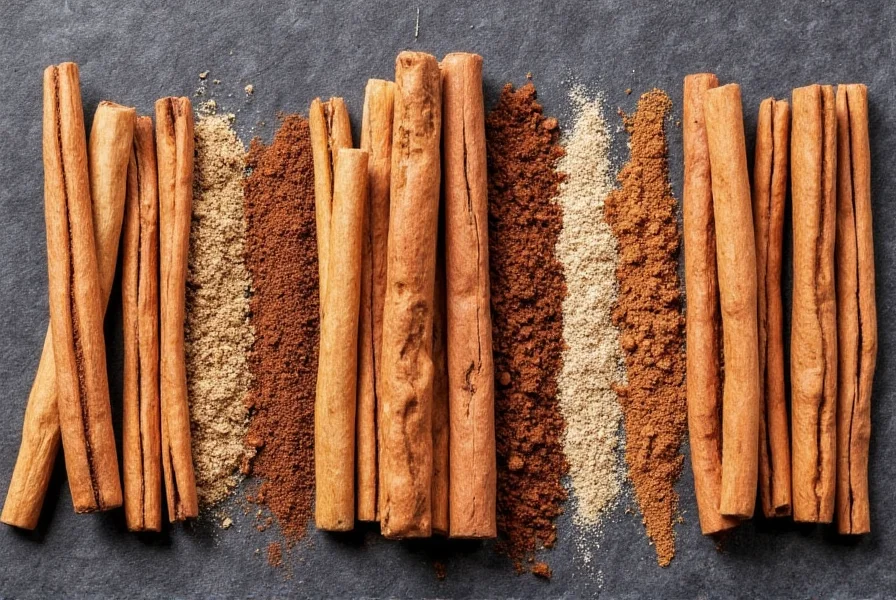When comparing Ceylon vs Cassia cinnamon, understanding their fundamental differences is crucial for making informed dietary choices. These two varieties, often confused in everyday cooking, have distinct characteristics that affect both health outcomes and culinary applications. Let's explore what sets them apart and which might be better suited for your specific needs.
What Exactly Is Ceylon Cinnamon?
Known as "true cinnamon," Ceylon cinnamon (Cinnamomum verum) originates from Sri Lanka and southern India. This delicate spice features multiple thin, papery layers that form a tight, soft quill. When you break a piece, it reveals a light brown color and releases a subtle, sweet aroma with citrus notes.
Ceylon cinnamon production involves carefully harvesting the inner bark of young trees, which is then rolled into characteristic layered quills. This labor-intensive process contributes to its higher price point compared to Cassia. The delicate structure means Ceylon cinnamon often comes in small, brittle sticks that crumble easily when handled.

Understanding Cassia Cinnamon
Cassia cinnamon, commonly labeled simply as "cinnamon" in supermarkets, comes primarily from China, Indonesia, and Vietnam. Botanically classified as Cinnamomum cassia, this variety features a single, thick, hard bark layer that forms a tight, hollow quill. Cassia has a darker reddish-brown color and delivers a stronger, more pungent flavor profile with noticeable heat.
The production process for Cassia involves harvesting mature tree bark that naturally curls into a single thick layer. This simpler harvesting method makes Cassia more economical to produce, accounting for approximately 90% of cinnamon sold in the United States. Its robust structure means Cassia sticks remain firm and difficult to break by hand.
Key Differences Between Ceylon and Cassia Cinnamon
| Characteristic | Ceylon Cinnamon | Cassia Cinnamon |
|---|---|---|
| Scientific Name | Cinnamomum verum | Cinnamomum cassia |
| Origin | Sri Lanka, Southern India | China, Indonesia, Vietnam |
| Bark Structure | Multiple thin, papery layers | Single thick, hard layer |
| Coumarin Content | Trace amounts (0.004%) | High (1-5%) |
| Flavor Profile | Milder, sweeter, with citrus notes | Stronger, more pungent, with heat |
| Price Comparison | More expensive (5-10x Cassia) | Affordable, widely available |
| Shelf Life | Shorter (loses flavor faster) | Longer (more stable) |
Health Implications: The Critical Coumarin Factor
The most significant difference between Ceylon vs Cassia cinnamon involves coumarin content. Coumarin, a naturally occurring compound, can cause liver damage when consumed in excessive amounts over time. Cassia contains substantially higher levels (1-5% by weight) compared to Ceylon's trace amounts (approximately 0.004%).
According to European Food Safety Authority guidelines, the acceptable daily intake of coumarin is 0.1 mg per kilogram of body weight. For a 150-pound adult, this translates to approximately 6.8 mg daily. Just one teaspoon of Cassia cinnamon contains 5-12 mg of coumarin, potentially exceeding safe limits with regular consumption. This makes Ceylon cinnamon the safer choice for daily use, especially for children, pregnant women, or those with liver conditions.
Both varieties offer similar antioxidant and anti-inflammatory benefits, with studies showing potential positive effects on blood sugar regulation. However, the coumarin concern makes Ceylon the preferred option when consuming cinnamon regularly for health purposes.
Culinary Applications and Flavor Profiles
Understanding the flavor differences between Ceylon and Cassia cinnamon helps determine which works best in various recipes. Ceylon's delicate, sweet profile with subtle citrus notes makes it ideal for:
- Desserts requiring nuanced spice notes
- Delicate baked goods like cakes and custards
- Teas and beverages where subtlety matters
- Recipes where cinnamon should complement rather than dominate
Cassia's stronger, more assertive flavor works better in:
- Robust baked goods like snickerdoodles and cinnamon rolls
- Spice blends like pumpkin pie spice
- Meat rubs and savory applications
- Recipes where cinnamon should provide prominent flavor

Practical Considerations for Consumers
When shopping for cinnamon, most supermarket varieties labeled simply as "cinnamon" are actually Cassia. To identify Ceylon cinnamon, look for:
- Multiple thin layers in the quill (vs Cassia's single thick layer)
- Lighter tan color (Cassia is darker reddish-brown)
- "Ceylon," "true cinnamon," or "Cinnamomum verum" on the label
- Higher price point (typically 5-10 times more expensive than Cassia)
For daily consumption, especially in therapeutic amounts, Ceylon cinnamon represents the safer option due to minimal coumarin content. However, for occasional baking where strong cinnamon flavor is desired, Cassia remains a perfectly acceptable choice that delivers excellent flavor at a more accessible price point.
Making the Right Choice for Your Needs
Selecting between Ceylon vs Cassia cinnamon ultimately depends on your specific use case:
- Daily health supplementation: Choose Ceylon for safety
- Regular baking: Cassia works well for most recipes
- Premium desserts: Ceylon provides more refined flavor
- Budget-conscious cooking: Cassia offers better value
- Children's recipes: Ceylon is safer due to lower coumarin
Many professional chefs and health-conscious consumers maintain both varieties in their pantries, selecting each based on the specific recipe requirements and consumption frequency. This approach maximizes both flavor potential and health considerations.











 浙公网安备
33010002000092号
浙公网安备
33010002000092号 浙B2-20120091-4
浙B2-20120091-4